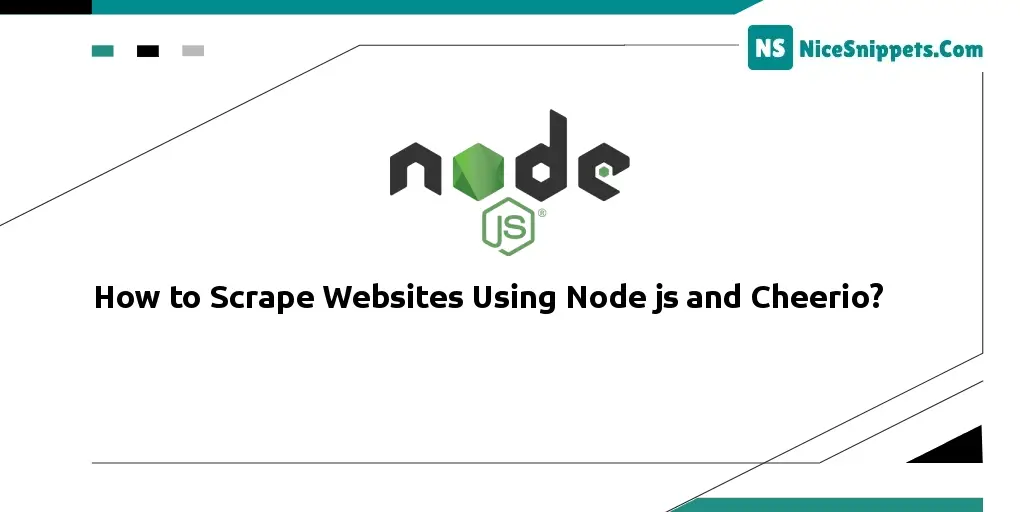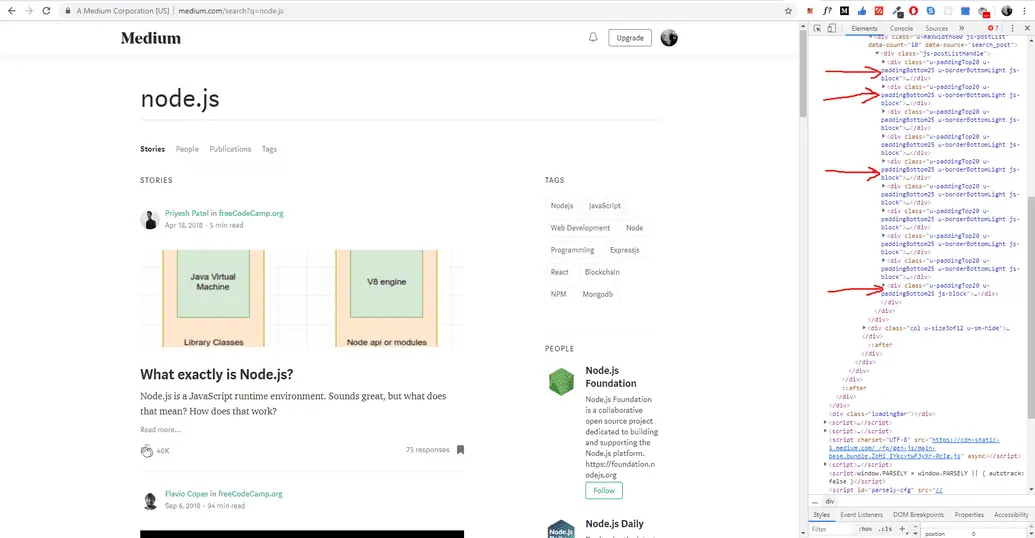23-Jan-2023
.
Admin

Hello Friends,
In this article, you'll learn how to do web scraping with Cheerio and NodeJS. Web scraping is extracting data from websites for specific use cases and analysis.
This tutorial will take you through how to use Cheerio to scrape Pokémon data from an example website, and then create a JSON file. Here we aim to teach you how you can use Cheerio in NodeJS to scrape any kind of web page, using Axios as an HTTP request client.
For Example, if you may want to scrape medium.com blog post using the following URL https://medium.com/search?q=node.js
After that, open the Inspector in chrome dev tools and see the DOM elements of it.

If you see it carefully, it has a pattern. we can scrap it using the element class names.
Step 1: Create Node js App
Let’s set up the project to scrape medium blog posts. Create a Project directory.
mkdir nodewebscraper
cd nodewebscraper
npm init --yes
Install all the dependencies mentioned above.
Then execute the following command on the terminal to install cheerio and express:
npm install express request cheerio express-handlebars
Step 2: Making Http Request
First, making the HTTP request to get the webpage elements:
request(`https://medium.com/search?q=${tag}`, (err, response, html) => {
//returns all elements of the webpage
})
Step 3: Extract Data From Blog Posts
Once you retrieve all the blog posts from medium.com, you can use cheerio to scrap the data that you need:
const $ = cheerio.load(html)
This loads the data to the dollar variable. if you have used JQuery before, you know the reason why we are using \$ here(Just to follow some old-school naming convention).
Now, you can traverse through the DOM tree.
Since you need only the title and link from scrapped blog posts on your web page. you will get the elements in the HTML using either the class name of it or the class name of the parent element.
Firstly, we need to get all the blogs DOM which has .js-block as a class name.
$(".js-block").each((i, el) => {
//This is the Class name for all blog posts DIV.
})
Most Importantly, each keyword loops through all the element which has the class name as js-block.
Next, you scrap the title and link of each blog post from medium.com.
$(".js-block").each((i, el) => {
const title = $(el)
.find("h3")
.text()
const article = $(el)
.find(".postArticle-content")
.find("a")
.attr("href")
let data = {
title,
article,
}
console.log(data)
})
This will scrap the blog posts for a given tag.
The full source code of node js web scraping:
app.js
const cheerio = require('cheerio');
const express = require('express');
const exphbs = require('express-handlebars');
const bodyParser = require('body-parser');
const request = require('request');
const app = express();
app.use(bodyParser.json());
app.use(bodyParser.urlencoded({extended : false}));
app.engine('handlebars', exphbs({ defaultLayout : 'main'}));
app.set('view engine','handlebars');
app.get('/', (req, res) => res.render('index', { layout: 'main' }));
app.get('/search',async (req,res) => {
const { tag } = req.query;
let datas = [];
request(`https://medium.com/search?q=${tag}`,(err,response,html) => {
if(response.statusCode === 200){
const $ = cheerio.load(html);
$('.js-block').each((i,el) => {
const title = $(el).find('h3').text();
const article = $(el).find('.postArticle-content').find('a').attr('href');
let data = {
title,
article
}
datas.push(data);
})
}
console.log(datas);
res.render('list',{ datas })
})
})
app.listen(3000,() => {
console.log("server is running on port 3000");
})
Step 4: Create Views
Next, you need to create one folder named layouts, so go to your nodewebscrap app and find the views folder and inside this folder create a new folder named layouts.
Inside a layout folder, create one view file named main.handlebars and update the following code into your views/layouts/main.handlebars file:
<!DOCTYPE html>
<html lang="en">
<head>
<meta charset="UTF-8">
<meta name="viewport" content="width=device-width, initial-scale=1.0">
<meta http-equiv="X-UA-Compatible" content="ie=edge">
<link rel="stylesheet" href="https://cdnjs.cloudflare.com/ajax/libs/semantic-ui/2.4.1/semantic.min.css">
<title>Scraper</title>
</head>
<body>
<div class="ui piled segment">
{{{body}}}
</div>
</body>
</html>
After that, create one new view file name index.handlebars outside the layouts folder.
nodewebscraper/views/index.handlebars
Update the following code into your index.handlerbars:
<form class="ui form" action="/search">
<input type="text" name="tag" placeholder="Search...">
<input type="submit" class="ui button" value="Search">
</form>
After that, create one new view file name list.handlebars outside the layouts folder.
nodewebscraper/views/list.handlebars
Update the following code into your list.handlebars:
<div class="ui list">
{{#each datas}}
<a class="item" href="{{article}}">{{title}}</a>
{{/each}}
</div>
<a class="ui teal tag label" href="/">Back</a>
Step 5: Start Node JS web Scrapping App server
npm install
npm run dev
Important Note:
Depending on your usage of these techniques and technologies, your application could be performing illegal actions.
I hope it can help you...
#Node JS